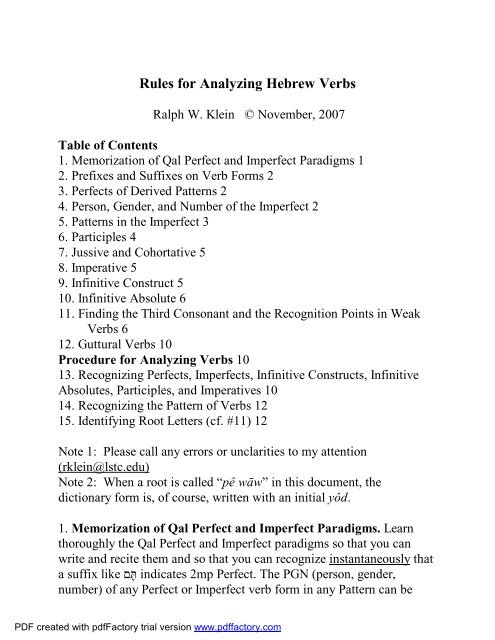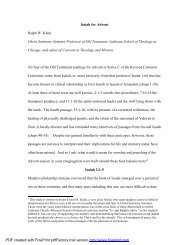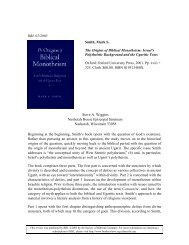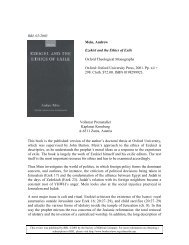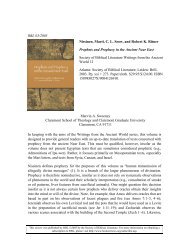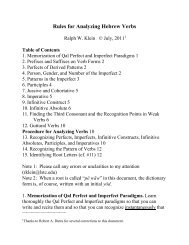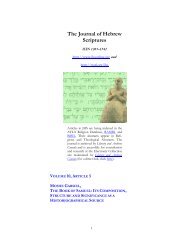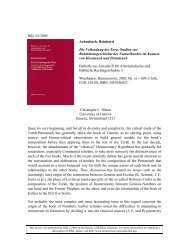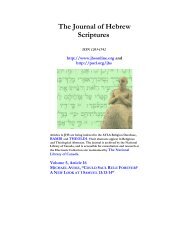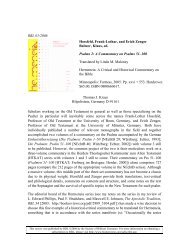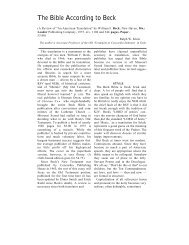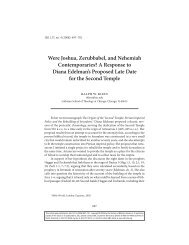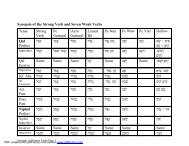Rules for Analyzing Hebrew Verbs
Rules for Analyzing Hebrew Verbs
Rules for Analyzing Hebrew Verbs
You also want an ePaper? Increase the reach of your titles
YUMPU automatically turns print PDFs into web optimized ePapers that Google loves.
<strong>Rules</strong> <strong>for</strong> <strong>Analyzing</strong> <strong>Hebrew</strong> <strong>Verbs</strong><br />
Ralph W. Klein © November, 2007<br />
Table of Contents<br />
1. Memorization of Qal Perfect and Imperfect Paradigms 1<br />
2. Prefixes and Suffixes on Verb Forms 2<br />
3. Perfects of Derived Patterns 2<br />
4. Person, Gender, and Number of the Imperfect 2<br />
5. Patterns in the Imperfect 3<br />
6. Participles 4<br />
7. Jussive and Cohortative 5<br />
8. Imperative 5<br />
9. Infinitive Construct 5<br />
10. Infinitive Absolute 6<br />
11. Finding the Third Consonant and the Recognition Points in Weak<br />
<strong>Verbs</strong> 6<br />
12. Guttural <strong>Verbs</strong> 10<br />
Procedure <strong>for</strong> <strong>Analyzing</strong> <strong>Verbs</strong> 10<br />
13. Recognizing Perfects, Imperfects, Infinitive Constructs, Infinitive<br />
Absolutes, Participles, and Imperatives 10<br />
14. Recognizing the Pattern of <strong>Verbs</strong> 12<br />
15. Identifying Root Letters (cf. #11) 12<br />
Note 1: Please call any errors or unclarities to my attention<br />
(rklein@lstc.edu)<br />
Note 2: When a root is called “pê wāw” in this document, the<br />
dictionary <strong>for</strong>m is, of course, written with an initial yôd.<br />
1. Memorization of Qal Perfect and Imperfect Paradigms. Learn<br />
thoroughly the Qal Perfect and Imperfect paradigms so that you can<br />
write and recite them and so that you can recognize instantaneously that<br />
a suffix like םתֶּ indicates 2mp Perfect. The PGN (person, gender,<br />
number) of any Perfect or Imperfect verb <strong>for</strong>m in any Pattern can be<br />
PDF created with pdfFactory trial version www.pdffactory.com
<strong>Rules</strong> <strong>for</strong> Verb Analysis (2)<br />
identified by knowledge of the Qal Paradigm. In every Pattern there are<br />
two stems: The Perfect Stem and the Imperfect Stem (usually the<br />
Imperative, Infinitive Construct and Infinitive Absolute, and Participle<br />
are based on the Imperfect Stem). In the Qal the Infinitive Absolute and<br />
Participle are not based on this stem and must be memorized. On the<br />
Niphal participle, see below.<br />
***********************************************************<br />
2. Prefixes and Suffixes on Verb Forms. Begin analysis of any verb<br />
<strong>for</strong>m by marking off the prefixes and suffixes.<br />
[ תְּ ]לטק [ הנָ]לטק[ת] [ וּ]םחנ<br />
The first example is Perfect 2fs (תְּ ), the second 3fp or 2fp Imperfect ( תּ<br />
הנָ), and all we can say about the third (וּ) is that it is 3 common plural<br />
perfect or masculine plural imperative.<br />
***********************************************************<br />
3. Perfects of Derived Patterns. For the Perfects of the Derived<br />
Patterns (everything but Qal), let the name of the Pattern be your guide<br />
(that is, the 3ms will sound like the name of the Pattern). Niphal begins<br />
with nûn, Piel and Pual have a dāgēš <strong>for</strong>te in their middle character and<br />
can be distinguished by their vowel sequence (i-e <strong>for</strong> Piel, or u-a <strong>for</strong><br />
Pual); Hiphil, Hophal, and Hithpael begin with Hi-, Ho- (qāmes. h.ātûp)<br />
and Hith- respectively.<br />
If the <strong>for</strong>m is perfect, as identified by the suffix, and there are no<br />
prefixes and no dāgēšes, the <strong>for</strong>m is Qal. e.g. יתִּ מְ קַ from םוּק<br />
***********************************************************<br />
4. Person, Gender, and Number of the Imperfect. If an Imperfect<br />
has a yôd prefix, it is a 3m <strong>for</strong>m (singular or plural);<br />
PDF created with pdfFactory trial version www.pdffactory.com
if it has a tāw prefix, it is a 3f or 2m-2f <strong>for</strong>m (singular or plural);<br />
if it has an āleph or nûn prefix it is a 1st person <strong>for</strong>m (singular<br />
and plural respectively).<br />
***********************************************************<br />
5. Patterns in the Imperfect. Identify the Pattern of Imperfects and<br />
other <strong>for</strong>ms based on the Imperfect Stem (usually the Imperative,<br />
Infinitive Construct and Infinitive Absolute, and Participle are based on<br />
the Imperfect Stem) by the recognition points.<br />
Qal: h.îreq-šĕwă . קְיִ or קְנִ , etc.<br />
<strong>Rules</strong> <strong>for</strong> Verb Analysis (3)<br />
Niphal: Niphal triangle לטֵקָּ יִ (a triangle is <strong>for</strong>med by h.îreq--dāgēš<br />
<strong>for</strong>te--qāmes.)<br />
With a Guttural ןמֵאָיֵ (Compensative lengthening instead of<br />
dāgēš <strong>for</strong>te)<br />
Pê Wāw בשֵׁוָּיִ (Note the Niphal triangle)<br />
(With a Hollow Verb ןוֹכּיִ The dāgēš results from the assimilation<br />
of the Nûn of the Niphal)<br />
Piel and Pual: A dāgēš <strong>for</strong>te will be in the middle letter and a vocal<br />
šĕwă under the prefix consonant; one can distinguish Piel from Pual<br />
by the sound of the vowels (a Pual will have a qibbûs. under the first root<br />
consonant).<br />
לטֵּ קַ יְ לטַּ קֻיְ<br />
The dāgēš in the middle letter sometimes disappears when<br />
there is a šĕwă under the letter (Seow, p. 59).<br />
Note: By definition, a Hollow verb cannot double its middle<br />
letter. Instead we have patterns called Polel (םמֵוֹקיְ) and<br />
Polal (םמַוֹקיְ). That is, the final letter of the Hollow root is<br />
PDF created with pdfFactory trial version www.pdffactory.com
<strong>Rules</strong> <strong>for</strong> Verb Analysis (4)<br />
doubled. The <strong>for</strong>ms above are Imperfects; these patterns also<br />
have all the other tenses.<br />
Hiphil: Note the patah. under the prefix ליטִקְיַ<br />
[Sometimes a patahD will show up in the Qal prefix be<strong>for</strong>e verbs<br />
beginning with a guttural דמֹ עֲיַ].<br />
Hophal: Note the qāmes. h.at.ûp under the prefix followed by a silent<br />
šĕwă לטַקְיָ.<br />
A qāmes. h.āt.ûp is a short vowel and appears only in a closed,<br />
unaccented syllable. Be<strong>for</strong>e dāgēš <strong>for</strong>te, the qāmes. h.āt.ûp is<br />
replaced by a qibbûs.. שׁגַּהֻ = Hophal Perfect from שׁגנ.<br />
Hithpael: yith-, tith-, eth-, or nith- prefix תְנִ ,תְאֶ ,תְתִ ,תְיִ There will also<br />
be a dāgēš <strong>for</strong>te in the middle letter of the root.<br />
Note: By definition a Hollow verb cannot double its middle letter.<br />
Instead we have Hithpolel (םמֵוֹקתְיִ). That is, the final letter of the root is<br />
doubled.<br />
***********************************************************<br />
6. Participles. In Piel through Hithpael the Participles begin with a<br />
mêm and are based on the imperfect stem.<br />
לטֵּ קַ מְ , לטָּ קֻמְ , ליטִקְמַ, לטָקְמָ, or לטֵּ קַ תְ מִ<br />
In the Qal and Niphal the participles are not based on the imperfect<br />
stem and must be memorized:<br />
Qal Active Qal Passive Niphal<br />
לטֵקֹ לוּטקָ לטָקְנִ<br />
םקָ (Qal active participle from a Hollow verb םוּק)<br />
PDF created with pdfFactory trial version www.pdffactory.com
<strong>Rules</strong> <strong>for</strong> Verb Analysis (5)<br />
***********************************************************<br />
7. Jussive and Cohortative. Jussives and Cohortatives express the<br />
speaker’s will to have a situation occur (May she...; let us...). The<br />
Jussive (3rd and 2nd person <strong>for</strong>ms) is distinguished from the Imperfect<br />
in the Strong Verb only in the Hiphil where the vowel is shortened in<br />
the second syllable. In all other Patterns the <strong>for</strong>ms can be either<br />
Imperfect or Jussive.<br />
Hiphil Imperfect ליטִקְיַ Hiphil Jussive לטֵקְיַ<br />
(In the weak verbs, the Jussive is distinguished from the imperfect by a<br />
shortening of the stem vowel. See #11 below)<br />
The Cohortative (1st person <strong>for</strong>ms) adds a final qāmes. he to the<br />
imperfect. הלָטְקְאֶ and הלָטְקנִ<br />
***********************************************************<br />
8. Imperative. The imperative is <strong>for</strong>med in the Qal and Piel by<br />
removing the prefix from the 2nd person imperfect <strong>for</strong>ms and making<br />
necessary vowel changes <strong>for</strong> other genders and numbers (see Rule of<br />
šĕwă , Seow, p. 56). In the Niphal, Hiphil, and Hithpael imperative, a<br />
hê replaces the tāw of the imperfect prefix, and in the Hiphil 2ms a s.ērê<br />
also replaces the h.îreq as the stem vowel.<br />
Qal לטֹ קְ Niphal לטֵקָּ הִ Piel לטֵּ קַ Hiphil לטֵקְהַ Hithpael לטֵּ קַ תְ הִ<br />
***********************************************************<br />
9. Infinitive Construct. The infinitive construct is <strong>for</strong>med the same<br />
way as the imperative 2ms in Qal, Niphal, Piel, and Hithpael. In the<br />
Hiphil, the infinitive construct is ליטִקְהַ .<br />
A final tāw (ת) indicates a Qal Infinitive construct in<br />
Pê Wāw: תבֶשֶׁ from בשׁי . (Note the loss of the initial yôd)<br />
With suffix: יתִּ בְ שִׁ. Cf. תכֶלֶ from ךלה.<br />
PDF created with pdfFactory trial version www.pdffactory.com
Pê Nûn: תשֶׁגֶּ from שׁגנ . (Note the loss of the initial nûn)<br />
With suffix יתִּ שְׁגִּ . Cf. תחַקַ from חקל. With suffix יתִּ הְ קַ .<br />
A final תוֹ is the sign of an Infinitive Construct in all Patterns <strong>for</strong><br />
Lāmed Hê verbs.<br />
Qal תוֹנבְּ from הנב Piel תוֹלּגַּ from הלג .<br />
***********************************************************<br />
10. Infinitive Absolute. The infinitive absolute, from Piel to<br />
Hithpael, has similar recognition points to those of the Imperfect.<br />
Piel לטֵּ קַ or לטּ ֹקַ (dāgēš <strong>for</strong>te in the middle letter of the root), Pual<br />
לטּ ֹקֻ (dāgēš <strong>for</strong>te in the middle letter of the root), Hiphil לטֵקְהַ<br />
(pathah. in the prefix), Hophal לטֵקְהָ (qāmes. h.āt.ûp in the prefix),<br />
and Hithpael לטֵּ קַ תְ הִ (hith- prefix and dāgēš <strong>for</strong>te in the middle<br />
letter of the root)<br />
In the Qal and Niphal the infinitive absolutes are not based on the<br />
imperfect stem. The Qal should be memorized.<br />
Qal לוֹטקָ Niphal לוֹטקְנִ or לוֹטקָּ הִ Both Niphal <strong>for</strong>ms are rare.<br />
***********************************************************<br />
11. Finding the Third Consonant and the Recognition Points in<br />
Weak <strong>Verbs</strong>. If only two root consonants appear in a verb <strong>for</strong>m, the<br />
following rules will help discover the third consonant.<br />
a. If there are only two root consonants, and the first is pointed<br />
with dāgēš <strong>for</strong>te, the word is Pê Nûn.<br />
שׁגַּיִ from שׁגנ . Cf. חקַּתִּ from חקל<br />
<strong>Rules</strong> <strong>for</strong> Verb Analysis (6)<br />
Pe Nûn verbs tend to have the first letter of the root<br />
assimilated (dāgēš <strong>for</strong>te appears in the following<br />
PDF created with pdfFactory trial version www.pdffactory.com
<strong>Rules</strong> <strong>for</strong> Verb Analysis (7)<br />
consonant). They act like the Strong <strong>Verbs</strong> in Piel and<br />
Pual.<br />
Niphal Perfect שׁגַּנִ from *שׁגַּנְנִ<br />
Hiphil Perfect שׁיגִּהִ from *שׁיגִּנְהִ<br />
Hophal Perfect (qibbûsD. replaces qāmes. hāt.ûp be<strong>for</strong>e a<br />
dāgēš <strong>for</strong>te) שׁגַּהֻ from *שׁגַּנְהָ<br />
Hophal Imperfect 1cs שׁגַּאֻ from the root שׁגנ .<br />
b. If there are only two root consonants, and the prefix and the first<br />
two root consonants (that is, up to the second consonant, but not<br />
beneath it) are pointed like the Strong Verb paradigm, the word is<br />
lāmed hê.<br />
וּלגְתִּ Qal Imperfect, 2mp, from הלג<br />
תָינִּעִ Piel Perfect, 2ms, from הנע<br />
The Jussives of Lāmed Hê <strong>Verbs</strong> are apocopated (shortened):<br />
Qal Imperfect הלֶגְיִ Qal Jussive לגֶיִ<br />
Qal wāw consecutive with imperfect לגֶיִּוַ<br />
Piel Imperfect הלֶּגַיְ Piel Jussive לגַיְ<br />
cf. wāw consecutive with the imperfect וצַיְוַ instead<br />
of הוֶּציְוַ<br />
Hiphil Imperfect הלֶגְיַ; Hiphil Jussive לגֶיֶ.<br />
Note: The common <strong>for</strong>m ךְיַּוַ is both pe nûn and lāmed hê from הכנ<br />
c. If there are only two root consonants, and they are separated by<br />
a long vowel, the word may be Hollow ( Ayin Wāw or Ayin Yôd).<br />
Note rules “c” and “d” belong together.<br />
Qal Imperfect Qal Jussive<br />
םוּקיָ and םישִׂיָ םקֹיָ and םשֵׂיָ<br />
PDF created with pdfFactory trial version www.pdffactory.com
<strong>Rules</strong> <strong>for</strong> Verb Analysis (8)<br />
Niphal Perfect Niphal Imperfect from ןוּכּ<br />
תָוֹנוּכנְ 2ms ןוֹכּנִ 1cp<br />
Hiphil Perfect of םוּק: םיקִהֵ 3ms; תָמֹיקִהֲ 2ms<br />
d. If there are only two root consonants, and the prefix of the<br />
imperfect is pointed with a qāmes. in an open syllable, the verb is<br />
Hollow and the pattern is Qal or Hiphil.<br />
Qal Imperfect םוּקיָ or םישִׂיָ from םוק and םישׁ.<br />
Qal Jussive םקֹיָ or םשֵׂיָ derived from םוּק or םישִׂ.<br />
Qal Imperfect with Wāw Consecutive םקָיָּPוַ or םשֶׂיָּPוַ derived<br />
from םוּק or םישִׂ. Note that the accent is on the yā syllable,<br />
making the final syllable closed and unaccented.<br />
Hiphil Imperfect םיקִיָ or םישִׂיָ derived from םוּק or םישִׂ.<br />
Hiphil Jussive םקֵיָ or םשֵׂיָ derived from םוּק or םישִׂ.<br />
Hiphil Imperfect with Wāw Consecutive םקֶיָּPוַ or םשֶׂיָּPוַ derived<br />
from םוּק or םישִׂ.<br />
Note: the Qal and Hiphil Imperfects of Ayin Yôd verbs<br />
are identical.<br />
םישִׂיָ is Qal or Hiphil Imperfect 3ms from םישִׂ.<br />
e. If there are only two root consonants, and the prefix is pointed<br />
with a Naturally Long vowel [a vowel usually written with a vowel<br />
letter], the word is Pê Wāw, Pê Yôd, or Hollow.<br />
Pê Wāw (the examples cited are from בשׁי, דלי and דרי).<br />
Niphal בשַׁוֹנ perfect. The imperfect is regular: בשֵׁוָּיִ<br />
PDF created with pdfFactory trial version www.pdffactory.com
(Niphal Triangle)<br />
Niphal infinitive construct דלֵוָּהִ .<br />
Hiphil Perfect דילִוֹה 3ms; תָּדְלַוֹה 2ms from דלי<br />
Hiphil Imperfect דילִוֹי from דלי<br />
Hophal דרַוּי and דרַוּה Imperfect and Perfect from דרי<br />
Pê Yôd (true pê yôd)<br />
Hiphil ביטִיהֵ from בטי<br />
<strong>Rules</strong> <strong>for</strong> Verb Analysis (9)<br />
Hollow<br />
Hophal םקַוּי and םקַוּה Imperfect and Perfect from םוּק.<br />
Note: Pê Wāw and Hollow roots have the same<br />
kind of Hophal <strong>for</strong>ms. Theoretically, םקַוּה<br />
could come from either םקי or םוק.<br />
The Hiphil perfect of Hollow verbs is םיקִהֵ (3ms) and<br />
תָוֹמיקִהֲ (2ms; note vowel reduction in the<br />
propretone). Though these <strong>for</strong>ms do not have a<br />
naturally long vowel in the prefix and there<strong>for</strong>e do<br />
not fit this rule, the hê prefix is a tipoff that they<br />
are Hiphil. The Hiphil participle of Hollow<br />
verbs is םיקִמֵ.<br />
f. If there are only two root consonants, and the prefix of the Qal<br />
Imperfect is pointed with a s.ērê, the word is Pê Wāw.<br />
וּבשְׁיֵ Qal imperfect 3mp from בשׁי. cf. ךְלֵיֵ from ךלה<br />
g. If there are only two root consonants, and none of the above<br />
rules applies, the word may be Ayin Ayin (the secondand third<br />
letters are identical.<br />
PDF created with pdfFactory trial version www.pdffactory.com
<strong>Rules</strong> <strong>for</strong> Verb Analysis (10)<br />
יתִוֹבּסַ ,ביסִהֵ ,בסֵּ יַּוַ are all from בבס (Qal Perfect 1cs, Hiphil<br />
Perfect 3ms, and Hiphil Imperfect with waw consecutive 3ms<br />
respectively).<br />
***********************************************************<br />
12. Guttural <strong>Verbs</strong>. Guttural verbs differ from Strong verbs in the<br />
following ways:<br />
F = no dāgēš <strong>for</strong>te; S = Silent šĕwă replaced by h.āt.ēp vowel; V =<br />
Vocal šĕwă is replaced by h.āt.ēp vowel; A = Preference <strong>for</strong><br />
“a-class” vowels. The letter rêš also does not take dāgēš<br />
<strong>for</strong>te.<br />
Piel perfect תָּנְאַמֵ with compensative lengthening<br />
רהַמִ with virtual doubling<br />
םחַנִ Niphal or Piel Perfect with virtual doubling<br />
ךְרֵבֵּ Piel Perfect. No dāgēš <strong>for</strong>te in the rêš;<br />
compensative lengthening<br />
Qal imperfect דמֹ עֲיַ h.āt.êp vowel <strong>for</strong> silent šĕwă and<br />
preference <strong>for</strong> “a” vowel<br />
Qal imperative דמֹ עֲ h.ātēp vowel <strong>for</strong> vocal šĕwă<br />
***********************************************************<br />
Procedure <strong>for</strong> <strong>Analyzing</strong> <strong>Hebrew</strong> <strong>Verbs</strong><br />
13. Recognizing Perfects, Imperfects, Infinitive Constructs,<br />
Infinitive Absolutes, Participles, and Imperatives. Examine words to<br />
see whether they show any suffixes of the Perfect or any prefixes (and<br />
suffixes) of the Imperfect. These clues will give you the tense and the<br />
Person, Number, and Gender.<br />
PDF created with pdfFactory trial version www.pdffactory.com
<strong>Rules</strong> <strong>for</strong> Verb Analysis (11)<br />
• A verb is an infinitive construct if it has a preposition in<br />
front of it (ל,כ,ב), or if it has possessive suffixes like those<br />
used on a noun. Other recognition points of the Imperfect<br />
also apply.<br />
לטֹ קְלִ, תוֹלגְבִּ, וֹתּשׁגִּ, לטֵּ קַ לְ , לטֵקָּ הִ לְ , וֹתבְשִׁלְ, ליצִּהַלְ<br />
(From left to right: Qal infinitive construct from a<br />
strong verb; Qal infinitive construct with a preposition<br />
from a lāmed hê verb; Qal infinitive construct with a<br />
3ms suffix from שׁגנ; Piel infinitive construct; Niphal<br />
infinitive construct; Qal infinitive construct from Pê<br />
wāw verb with a 3ms suffix; Hiphil infinitive construct<br />
from a pê nûn verb).<br />
Infinitive constructs <strong>for</strong> Lāmed Hê verbs end in תוֹ<br />
Infinitive constructs <strong>for</strong> Pê Yôd and Pê Nûn verbs<br />
end in ת<br />
• A verb is an infinitive absolute if it is used immediately<br />
be<strong>for</strong>e or immediately after a finite verb of the same root.<br />
Qal = לוֹטקָ. In other patterns, standard recognition<br />
points <strong>for</strong> the Imperfect apply in identifying the<br />
Infinitive Absolute.<br />
• A verb is a participle if it is לטֵקֹ , לוּטקָ in the Qal (active and<br />
passive respectively), לטָקְנִ in the Niphal, or has a מ prefix in<br />
Piel--Hithpael (other Imperfect recognition points apply).<br />
• A verb is probably an imperative if an imperative is used<br />
in an English translation! Imperatives are <strong>for</strong>med by<br />
removing the ת prefix from the second person <strong>for</strong>ms of the<br />
Imperfect in Qal or Piel, or by replacing it with a ה (in<br />
Niphal, Hiphil, and Hithpael; other Imperfect recognition<br />
points apply).<br />
PDF created with pdfFactory trial version www.pdffactory.com
<strong>Rules</strong> <strong>for</strong> Verb Analysis (12)<br />
14. Recognizing the Pattern of <strong>Verbs</strong>. Determine the Pattern of the<br />
verb:<br />
A. If the verb (according to #13 above) is Perfect, the recognition<br />
points are the following:<br />
Qal--no prefixes, no dāgēšes<br />
Niphal--Nûn prefix<br />
Piel-Pual--dāgēš <strong>for</strong>te in middle letter. (Look<br />
<strong>for</strong> the “u” vowel in the Pual)<br />
Hiphil--ה prefix (הִ [strong verbs], וֹה [pê wāw].הֵ<br />
or הֲ [hollow], הֶ [gutturals])<br />
Hophal--קְהָ , (וּה [pê wāw or hollow], הֻ [pê nûn])<br />
Hithpael--תהִ<br />
B. If the verb (according to #13 above) is Imperfect, the<br />
recognition points are the following:<br />
Qal--קְיִ (יֵ, תֵּ , אֵ, נֵ <strong>for</strong> Pê Yôd; יָ etc. <strong>for</strong> Hollow)<br />
Niphal--קָּ יִ (Niphal triangle). ןמֵאָיֵ with inital<br />
guttural<br />
Piel-Pual--לטּקיְ (Note šĕwă under the prefix and<br />
dāgēš <strong>for</strong>te in the middle letter)<br />
Hiphil--קְיַ (וֹי Pê wāw; ייֵ Pê yôd, יָ Hollow)<br />
Hophal--קְיָ (וּי <strong>for</strong> Hollow or Pê Yôd; יֻ <strong>for</strong> )<br />
Hithpael--תְיִ, etc.<br />
15. Identifying Root Letters. Identify the root letters in the <strong>for</strong>m-usually<br />
two or three will be present. Choose the third letter. See #11<br />
above <strong>for</strong> a list of rules on how to determine the third root consonant.<br />
For additional help in understanding <strong>Hebrew</strong> verb <strong>for</strong>ms see OT-<br />
Studies.com (http://prophetess.lstc.edu/rklein). Look on the second<br />
drop down menu under <strong>Hebrew</strong>.<br />
PDF created with pdfFactory trial version www.pdffactory.com


